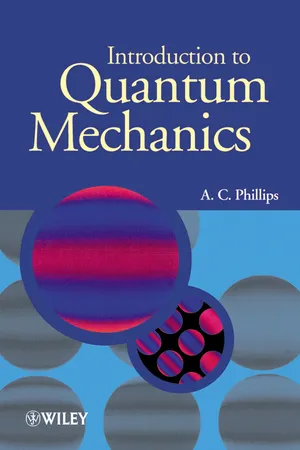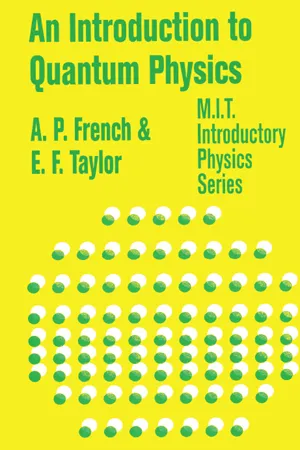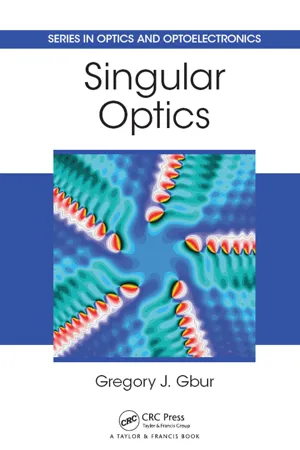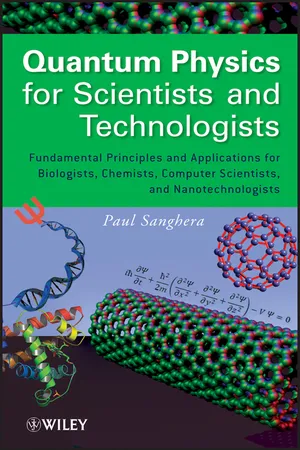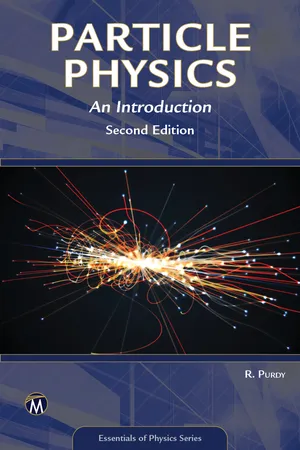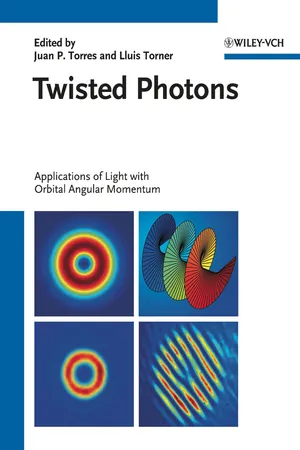Physics
Quantum Orbital Angular Momentum
Quantum orbital angular momentum refers to the intrinsic angular momentum of a particle as it orbits around a central point, as described by quantum mechanics. It is quantized, meaning it can only take on certain discrete values. This concept is fundamental in understanding the behavior of electrons in atoms and plays a crucial role in the interpretation of atomic spectra.
Written by Perlego with AI-assistance
Related key terms
Related key terms
1 of 4
Related key terms
1 of 3
10 Key excerpts on "Quantum Orbital Angular Momentum"
- eBook - ePub
- A. C. Phillips(Author)
- 2013(Publication Date)
- Wiley(Publisher)
. They also showed, by measuring the separation between the two beams of atoms emerging from the electromagnet, that the magnitude of the magnetic moment of a silver atom is of the order of a Bohr magneton.8.3 ORBITAL ANGULAR MOMENTUM
In this section we shall remind the reader of the definition of orbital angular momentum in classical physics, introduce the operators which describe orbital angular momentum in quantum physics, and then consider how the angular shapes of wave functions are related to orbital angular momentum properties. In so doing, we shall confirm some of the general statements made about orbital angular momentum in Section 8.1.Classical orbital angular momentum
Consider a particle at time t with vector position and momentumThe orbital angular momentum about the origin of coordinates is given by the vector product which is a vector with three Cartesian components, and a magnitude given byQuantum Orbital Angular Momentum
Orbital angular momentum in quantum physics is described by the operator(8.17)This a vector operator with three Cartesian components,that act on wave functions representing possible quantum states of a particle.3When the wave function Ψ(r, t ) is known, expectation values for orbital angular momentum may be calculated. For example, the integralsgive the expectation values for the x component and the square of the x component of the orbital angular momentum. And when the wave function is an eigenfunction of x with eigenvalueLx, i.e. whenwe can follow the procedure outlined in Section 4.3 and show that 〈Lx〉 =Lxand that . This implies that the uncertainty is zero and that the eigenfunction represents a quantum state with a precise value for the x component of the orbital angular momentum given by the eigenvalueLx - eBook - ePub
- A.P. French(Author)
- 2018(Publication Date)
- Routledge(Publisher)
z the azimuthal angle ϕ is completely undetermined.This pictorial representation of the angular momentum vector is sometimes called space quantization, although it is quantization not of space but of the “orientation” of Lin space. Like all classical representations of quantum-mechanical results, the visualization can be misleading and must be used with caution. For example, it may lead to experimentally meaningless questions such as, “In what direction is the angular momentum vector really pointing at such-and-such an instant?” However, if the limitations of the model are kept in mind, it is a helpful aid that is used by most physicists.The description we have developed here in terms of angular wave functions is far removed from the classical picture of an orbiting particle with which we began this analysis. In the wave function we have the basis of a probability distribution for a large number of identical systems in a given angular momentum state. The description of a localized particle in orbit requires a superposition of eigenfunctions analogous to the packet state that describes motion in one dimension.11-3 ROTATIONAL STATES OF MOLECULESBefore we can apply our knowledge of quantized angular momentum to the structure of individual atoms (chapters 12 and 13 ), we will need to take account of the angular momentum due to the spin of the electron itself, as described in Section 11-4 below. However, using only our present knowledge of orbital angular momentum we can make a simple and powerful analysis of the rotation of slightly larger systems: molecules. To a good approximation, discussed more fully below, molecules can be treated as rigid rotators that revolve without changing the separations or relative positions of their constituent atoms. In the simplest case, that of a diatomic molecule, one has the classical picture of the two atoms of the molecule revolving with fixed separation at opposite ends of a line that passes through their common center of mass (Figure 11-4 ). In what follows we recall a previous treatment of molecular vibrations in Chapter 4 - eBook - ePub
- Mark Julian Everitt, Kieran Niels Bjergstrom, Stephen Neil Alexander Duffus(Authors)
- 2023(Publication Date)
- Wiley(Publisher)
If you have any experience with chemistry, you will likely have already drawn the correct conclusion that these states are closely related to atomic orbitals – a subject we will later return to. 5.4 Addition of Angular Momentum 5.4.1 The General Theory In classical mechanics, the total angul ar momentum of a system of particles is the sum of the angular momenta of each particle. For a system of particles the total angular momentum may be an integral of the motion but the individual angular momenta are not. We now consider the quantum case of the angular momentum of a system of ‘particles’ (by particle we mean a subsystem for which an angular momentum can be defined). The spaces of each particle are denoted in parentheses, so that is the component of angular momentum in the second space and is the square of the angular momentum in the fourth space. To reduce the burden of notation, we will use the same symbol for the operator within each space and its extension to the full tensor product space. The commutation relation of each component of angular momentum is given by (5.76) Here, is the Levi–Civita antisymmetric symbol that describes the permutations of and denotes the commutation of operators in different subspaces. We will make use of a shorthand for the state (5.77) The operators can be used to form a CSCO. This is very useful for some problems (especially a set of two-level systems, where this would be a CSCO. For qubits (quantum bits) this is the computational basis and it is also a standard choice for studying spin chains. The actions of and on the ket is, as before, given by: (5.78) Just as with classical mechanics there are a number of systems where the total angular momentum may commute with the system Hamiltonian, but the do not. For those systems, an alternative basis is of greater utility - eBook - ePub
Structured Light and Its Applications
An Introduction to Phase-Structured Beams and Nanoscale Optical Forces
- David L. Andrews(Author)
- 2011(Publication Date)
- Academic Press(Publisher)
Chapter 11 Orbital Angular Momentum in Quantum Communication and InformationSonja Franke-Arnold1 , John Jeffers2 ,1 University of Glasgow, Scotland2 University of Strathclyde, Glasgow, ScotlandLight has a long tradition in serving as a model representation for quantum communication systems. Its polarization provides two orthogonal states, for example, horizontal, and vertical, which can be used to encode one bit of information in a quantum system (say, horizontal represents 0 and vertical represents 1). The system does not necessarily need to be horizontally or vertically polarized; it could be left or right circularly polarized or linearly polarized at some other angle. This allows the system to be in a superposition of the orthogonal bit states and therefore to represent what is known as a qubit. Various alternative physical qubit systems are competing in the run toward other feasible quantum information applications, including cold trapped ions, Bose condensates, and quantum dots. Polarized light, however, is particularly suitable for proof of principle investigations, as its generation, manipulation, and detection is comparatively simple, fast, and inexpensive. The field is advancing rapidly, and quantum key distribution has already entered the public domain [1 ].In 1992 Les Allen and colleagues showed that light can carry orbital angular momentum (OAM), and, in particular, that an azimuthal phase dependence ei φof a light beam corresponds to units of orbital angular momentum [2 ]. Such phase dependence is characteristic of either Laguerre–Gaussian or Bessel modes. Each of these mode families provides an infinite-dimensional orthogonal basis set, and with hindsight it seems obvious to employ OAM modes as representations of higher-dimensional qubits called qunits (sometimes qudits ). It took about a decade until the advent of the first quantum mechanical studies of orbital angular momentum, and Zeilinger’s group stated in their landmark experiment on OAM entanglement [3 - eBook - ePub
- Gregory J. Gbur(Author)
- 2016(Publication Date)
- CRC Press(Publisher)
orbital component of the angular momentum as well. This latter aspect was only put under serious scrutiny quite recently [ABSW92], possibly coinciding with the growth of singular optics as a field. Since then, there has been extensive research on the subject; see, for instance, the collection edited by Allen, Barnett, and Padgett [ABP03].The study of optical angular momentum comes with certain conceptual difficulties. Light is not a rigid or even massive body, leaving significant ambiguity on how to define the “axis” of rotation for orbital angular momentum (OAM). Furthermore, there is great uncertainty in how to describe the linear momentum of light, and therefore also the angular momentum, while it is traveling in matter, resulting in the 100-year-and-counting Ambraham–Minkowski controversy.Optical angular momentum plays an important role in both practical applications and natural phenomena. In astronomy, it has been observed that complicated light interactions with asymmetric asteroids can change the asteroids’ rotation, in what is known as the YORP effect (see, for instance, [LFP+ 07]). In microscopy, the momentum and angular momentum of light is now regularly used to trap and rotate small objects in a technique known as optical tweezing, to be discussed in some detail in Chapter 6 .In this chapter, we discuss both the momentum and angular momentum of light and conceptual challenges associated with them. We start by returning to Maxwell’s equations and deriving the appropriate conservation laws in terms of electric and magnetic fields.5.1 MOMENTUM AND ANGULAR MOMENTUM IN WAVEFIELDSWe begin by considering a region of space that contains time-fluctuating electric and magnetic fields E(r, t) and B(r, t). Let us consider the force F(r, t) on a point particle of charge q - eBook - ePub
Quantum Physics for Scientists and Technologists
Fundamental Principles and Applications for Biologists, Chemists, Computer Scientists, and Nanotechnologists
- Paul Sanghera(Author)
- 2011(Publication Date)
- Wiley-Interscience(Publisher)
L .Because both S and L represent some type of angular momentum, the relationship between S and s is identical to the relationship between L and l , that is,(8.1)The major difference between s and l is that s can have only one value: .Note : Each electron has a spin whose magnitude is always the same for all the electrons and is ½, which follows from spectral data and also from the relativistic quantum mechanics that we are not discussing in this book. Some particles have integral spin. For example, photons have a spin of 1.Recall from Section 7.5.3 that the space quantization of angular momentum is represented bywhereSimilarly, space quantization of spin angular momentum is represented bymlis called the magnetic quantum number. The orbital angular momentum can have 2l + 1 orientations corresponding to 2l + 1 values ofmlgiven by(8.2)wheremsis called the spin magnetic quantum number. The spin angular momentum can have 2s + 1 orientations corresponding to 2s + 1 values ofmsgiven by(8.3)As shown by Eq. 8.2 , the spin magnetic quantum numbermsdetermines the component of the spin angular momentum along a magnetic field in the z direction. The magnetic moment due to spin is called the spin magnetic momentμsgiven by the following equation:(8.4)where m is the mass of the electron. Due to the space quantization of spin angular momentum S , spin magnetic moment can only have limited values along an axis. As shown in Problem 8.8, the possible values ofμsalong the z - eBook - ePub
Particle Physics
An Introduction
- Robert Purdy(Author)
- 2022(Publication Date)
- Mercury Learning and Information(Publisher)
. To do so, consider the Schrödinger equation and its complex conjugate:(3.16)Now we multiply the first of these by ψ * and the second by ψ :(3.17)Subtracting one from the other, we find(3.18)where ρ = ψ * ψ and we have identified the current as(3.19)or(3.20)This, then, is the probability density current that quantifies how probability moves around in the system. We will see later that the correct interpretation of a similar conserved current in the relativistic case is an important part of understanding particle physics.3.4. ANGULAR MOMENTUM AND SPINA particularly important, and relevant, example that demonstrates some of the ideas of quantum mechanics is that of angular momentum. The (classical) orbital angular momentum of an object is given by(3.21)where r is the object’s position vector and p is the object’s momentum. Since operators bear the same relations to each other as their classical counterparts, we can define the orbital angular momentum operator as(3.22)That is,(3.23)Looking at the commutation relations for the individual components of angular momentum, we find(3.24)Since no two of these components commute, it is impossible to measure two distinct components of angular momentum simultaneously. In fact, it is meaningless even to consider the value of one component if another component is known: it is simply not defined. However, it is possible to measure simultaneously one component and the overall magnitude of the angular momentum L 2 , since L 2 commutes with all three of the components. We will see later that this is an example of a Casimir , and will also see how this idea generalizes to other systems. So while it makes no sense to ask what all individual components of angular momentum are, we can ask what one component is (conventionally the z component) as well as the overall magnitude. This means that angular momentum eigenstates have two eigenvalues associated with them: one for each simultaneously measurable quantity. It can be shown that the possible values of L 2 are constrained to be of the form l (l + 1) where l is an integer, while the possible values of L z are constrained to be integers m such that −l ≤ m ≤ l . These constraints arise from the consistency of the eigenstate solutions to the Schrödinger equation under rotation through 2π . Specifically, it may be derived from the spherical harmonics (see Section 6.4.3 - eBook - ePub
Twisted Photons
Applications of Light with Orbital Angular Momentum
- Juan P. Torres, Lluis Torner(Authors)
- 2011(Publication Date)
- Wiley-VCH(Publisher)
1 The Orbital Angular Momentum of Light: An Introduction Les Allen and Miles Padgett 1.1 IntroductionMost physicists know that polarized light is associated with the spin angular momentum of the photon. It is almost certainly true that the idea of orbital angular momentum is a good deal less understood. Perhaps the simplest and most obvious display of both the spin and orbital angular momentum of light beams comes from an examination of the ratio of their angular momentum to their energy.For an idealized, circularly-polarized plane wave, the spin angular momentum is given by J z = N and the energy by W = N ω, where N is the number of photons. The angular momentum to energy ratio is thus,1.1In fact the ratio in Eq. (1.1 ) is derivable from classical electromagnetism without any need to invoke the concept of a photon or any other quantum phenomenon [1].A slightly more general result for elliptically polarized light, characterized by − 1 ≤ σ ≤ + 1, (with σ = ± 1 for left- and right-handed circularly polarized light respectively and σ = 0 for linearly polarized light) is given by1.2We can show for a light beam which has an l -dependent azimuthal phase angle such that the field amplitude is given by u (x , y , z , ϕ) = u 0 (x , y , z )e−ikze+il ϕ, that Eq. (1.2 ) becomes [2]1.3Here σ describes the spin angular momentum per photon, while l describes the orbital angular momentum per photon. In the absence of the phase term exp(il ϕ), Eq. (1.3 ) would be the usual plane wave ratio of spin angular momentum divided by energy, namely, σ/ ω or σ per photon.It transpires that this simple result is true both in the limit of the paraxial approximation and for fields described by a rigorous and unapproximated application of Maxwell's equations [3]. In the paraxial approximation, other than assuming that u (x , y , z ) is normalizable and leads to a finite energy in the beam, no assumption has been made about the form of the distribution. In other words even for σ = 0, when the light is linearly polarized, there remains an angular momentum related to the spatial properties of the beam and dependent on l - eBook - ePub
Photonics, Volume 1
Fundamentals of Photonics and Physics
- David L. Andrews(Author)
- 2015(Publication Date)
- Wiley(Publisher)
In 1932, Darwin (the grandson of the famous evolutionary scientist) described how a photon emitted a short distance from the center of mass of an atom would provide the additional angular momentum needed for higher order transitions [4]. This angular momentum eventually become known as orbital angular momentum (OAM). In 1992, Allen et al. released a seminal article that described OAM as a natural property of light beams with helical phase fronts and noted that these beams could be generated quite easily in the laboratory [3]. OAM-carrying beams often take the form of (but not limited to) Laguerre-Gaussian (LG) beams, with amplitude distributions, LG pl described as (10.1) where r is the radius, w (z) = w (0)[(z 2 + z 2 R)/ z R 2 ] 1/2 with w (0) as the beam waist, z R as the Rayleigh range, and (2 p + | l | + 1)tan − 1 (z / z R) as the Gouy phase [5]. L | l | p is a Laguerre polynomial that is a result of (10.2) where l is the azimuthal index resulting in OAM of L = l ℏ per photon, as shown in Figure 10.1, and p is the number of radial nodes in the intensity distribution. The simplest OAM beam has a phase in the transverse plane of φ(θ) = l θ, where θ is the angular coordinate and l is any integer. Allen et al. derived that all light beams with helical phase fronts described by e il θ have an OAM of l ℏ per photon [3]. This value for the OAM is consistent with a simple geometrical argument based on the helical phase fronts. The local momentum flow is directed along a normal to the phase fronts. For helical phase fronts, this implies that the local momentum flow is not directed in the global direction of beam propagation, rather than it is skewed to the beam axis by an angle β = l / k 0 r [6,7], where k 0 = 2π/λ is the wavenumber and λ is the wavelength of light - eBook - ePub
- Kenneth W Ford(Author)
- 2016(Publication Date)
- WSPC(Publisher)
Zeeman Effect and Multiplet Structure (Berlin: Springer-Verlag, 1925).]149For the third quantum number, the summarizing statement on page 669 must be modified slightly:(3) Orbital Orientation Quantum NumberFor the fourth quantum number, we have the summarizing statement:(4) Spin Orientation Quantum NumberAltogether, the state of motion of a single electron in the hydrogen atom is characterized by the set of quantum numbers,Since ms can take on two distinct values, the fact that the electron is spinning doubles the number of states of motion. Table 24.2 lists the possible combinations of quantum numbers for the lowest two energy levels in hydrogen. The n = 2 floor of the Balmer transitions actually consists of eight different states of motion. The energies of these eight states are not all identical. They divide into three slightly different energies, contributing to what is called the fine structure of the spectrum. In a magnetic field the energy is further subdivided into eight separate closely spaced levels, since no two of the states have identical magnetic properties.An alternative set of quantum numbers for the electron corresponds more closely to the actual physical situation in the hydrogen atom. Instead of imagining the two angular momenta, orbital and spin, to be separately oriented in space, we can first combine these two into a total angular momentum (designated by J), this total then being oriented in space, with orientation quantum number mj . The alternative set of quantum numbers isn, ℓ, j, mj .with the restriction that j is equal to ℓ + ½ or ℓ – ½ (unless ℓ = 0, in which case j = ½, since then the total angular momentum is the same as the spin angular momentum). As Table 24.3 makes clear, the number of distinct states of motion is unchanged by the alternative classification. Either scheme of quantum numbers provides an equally satisfactory basis for understanding the structure of heavy atoms. Since the physical picture underlying our first set (n, ℓ, mℓ , ms
Index pages curate the most relevant extracts from our library of academic textbooks. They’ve been created using an in-house natural language model (NLM), each adding context and meaning to key research topics.
Explore more topic indexes
Explore more topic indexes
1 of 6
Explore more topic indexes
1 of 4
